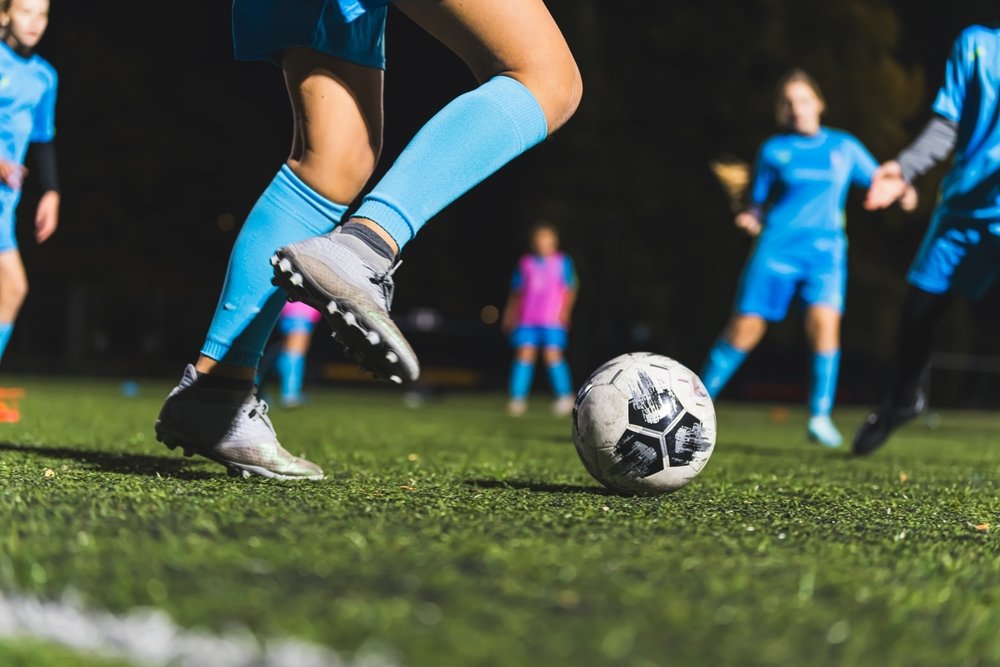 Every year, around 413,000 student soccer players are injured while playing the sport. These injuries can range from minor strains to more severe conditions that could sideline them for an entire season. Understanding how to avoid these injuries is crucial to keep the game enjoyable and safe for our budding athletes.
Every year, around 413,000 student soccer players are injured while playing the sport. These injuries can range from minor strains to more severe conditions that could sideline them for an entire season. Understanding how to avoid these injuries is crucial to keep the game enjoyable and safe for our budding athletes.
At OAA Orthopedic Specialists, our sports medicine experts are dedicated to helping young athletes stay healthy and active. Our experienced team understands the specific challenges soccer players face and can provide tailored treatment plans, injury prevention strategies, and rehabilitation services. If you or your child have concerns about injuries, use our 24/7 orthopedic injury advice app HURT! or schedule an appointment with us today!
Click Here To Book A Specialist
In this blog, we’ll explore the ten most common soccer injuries to watch out for this fall and share tips on how to prevent them.
Common Soccer Injuries, Head to Toe
1) Concussions
Though often thought of as an issue only for football players, concussions (also known as mild traumatic brain injuries) are among the most serious and common injuries that can occur in soccer. They typically result from a direct blow to the head or a jarring motion that causes the brain to move within the skull.
This type of traumatic injury can lead to symptoms such as confusion, dizziness, and headaches, which require immediate attention. It’s crucial for coaches, players, and parents to recognize the signs of concussions and to implement appropriate protocols for head injury management. Early intervention and a proper recovery plan are essential for athletes to return to the game safely and minimize the risks associated with repeated concussions.
2) Wrist Sprain
Wrist sprains are common injuries in soccer, often occurring when players fall or attempt to break their fall with their hands. This sudden impact can stretch or tear the ligaments that support the wrist joint. Symptoms typically include pain, swelling, bruising, and limited range of motion in the affected wrist.
3) Sports Hernia
A sports hernia, also known as athletic pubalgia, is a painful condition that occurs when soft tissue in the groin region is torn or damaged. This injury often arises from intense physical activity, particularly involving sudden changes in direction and heavy lifting. Symptoms may include groin pain, which can worsen with activity or when coughing and sneezing.
4) Groin Pulls
Similar to sports hernias, groin pulls also affect the soft tissues in the groin and inner thigh area. Groin pulls occur when these tissues are overstretched or torn, often resulting from sudden movements like sprinting, kicking, or changing direction. These injuries are common in soccer players due to the quick lateral motions inherent in the sport.
Symptoms typically include a sharp pain in the groin area, swelling, bruising, and difficulty walking or running. Players may also experience muscle stiffness or tenderness when attempting to use the affected leg.
5) Hamstring Strains
Hamstring strains are one of the most prevalent injuries in soccer, often occurring when players sprint, jump, or change direction rapidly. This injury involves the overstretching or tearing of muscles at the back of the thigh, which can happen due to excessive force during high-speed movements or from inadequate warm-up.
Symptoms of a hamstring strain include sudden pain in the back of the thigh, swelling, and tenderness, along with difficulty straightening the leg. Players may also experience muscle spasms and a reduced range of motion.
6) Knee Injuries
Knee injuries, particularly those involving the anterior cruciate ligament (ACL), are common among soccer players. These injuries often occur during sudden stops, jumps, or changes in direction, as the ACL provides stability to the knee. When the knee is subjected to excessive twisting or force, it can result in tears.
Symptoms of an ACL injury may include a loud popping sound at the moment of injury, severe pain, swelling, and a feeling of instability in the knee. Recognizing the signs of an ACL injury early is crucial, as timely treatment can significantly affect recovery and return to play after these soccer injuries occur.
7) Shin Splints
Shin splints, or medial tibial stress syndrome, are a common soccer injury that many players experience. This condition typically arises from repetitive stress on the shinbone and the surrounding tissues, often caused by sudden increases in activity, improper footwear, or playing on hard surfaces. Symptoms include pain along the inner edge of the shin, tenderness, and sometimes swelling.
8) Achilles Tendon Injuries
Achilles tendon injuries are common in soccer, particularly among players who engage in rapid sprints and sudden stops. This injury occurs when there is overstretching or excessive strain on the Achilles tendon, which connects the calf muscles to the heel bone.
Factors such as inadequate warm-up, tight calf muscles, or sudden increases in training intensity can contribute to this injury. Symptoms often include sharp pain at the back of the ankle, swelling, and stiffness, especially in the morning or after periods of inactivity.
9) Ankle Sprains
Ankle sprains are among the most common soccer-related injuries. This injury often occurs when a player lands awkwardly after a jump or twists the ankle while running.
Symptoms of an ankle sprain can include immediate pain, swelling, bruising, and difficulty bearing weight on the affected foot. Depending on the severity, players might experience instability in the ankle.
10) Lisfranc Injuries
A Lisfranc injury refers to damage to the midfoot, specifically the complex of bones and ligaments that connect the toes to the rest of the foot. This type of injury can occur when a player falls, twists, or experiences a direct blow to the foot, though it most often happens during sudden changes in direction or when landing awkwardly after a jump.
Symptoms typically include severe pain in the foot, swelling, and bruising, particularly on the top of the foot. Players may also notice difficulty bearing weight or walking. Given their complexity, Lisfranc injuries can take a long time to heal, so early diagnosis and appropriate treatment are essential for a safe return to the field.
Treatment Options
When it comes to managing soccer injuries, having a solid treatment plan is key to a quick recovery and getting back on the field. Here are some common treatment options that can help:
- Rest: This is usually the first step. Taking a break from playing allows your body to begin healing and reduces the risk of further injury.
- Ice Therapy: Applying ice to the injured area can help with swelling and pain. It’s a good idea to ice for 15-20 minutes every few hours, especially in the first couple of days after the injury.
- Compression and Elevation: Using an elastic bandage to wrap the injured area can help reduce swelling and promote healing, as can elevating the injured limb above heart level.
- Physical Therapy: A trained physical therapist can design a custom rehabilitation program that includes exercises to restore strength, flexibility, and range of motion. This is particularly important for more serious injuries.
- Medication: Over-the-counter pain relievers, like ibuprofen or acetaminophen, can help alleviate pain and reduce inflammation.
- Surgery: In more severe cases, particularly with major ligament tears, surgical options may be necessary to repair the injury. If surgery is required, a structured rehab plan afterward is crucial for a successful recovery.
- Gradual Return to Activity: Once cleared by a medical professional, athletes should ease back into play, starting with lighter activities and progressively increasing intensity to avoid re-injury.
Tips for Injury Prevention
Most soccer injuries involve the muscles, joints, and ligaments, often stemming from inadequate preparation or improper technique. To minimize the risk of overuse injuries, encourage your player to:
- Warm-Ups: A proper warm-up helps to increase blood flow to the muscles, preparing them for the demands of the game ahead. This should include dynamic stretches and light aerobic exercises that mimic the movements involved in soccer.
- Cool-Downs: Cool-downs help gradually lower the heart rate and prevent stiffness by stretching the muscles. This is especially important after intense training or a game.
- Strength Training: Regular strength training and conditioning are crucial for building the overall muscle stability and endurance necessary for soccer's fast-paced nature. By focusing on exercises that target key muscle groups, players can enhance their strength, improve balance, and become more resilient to injuries like strains and sprains.
- Proper Technique: Correct form and technique are essential to prevent injuries, especially for movements that involve quick changes in direction or jumping. Coaches should emphasize proper technique during training sessions, allowing players to develop good habits and avoid putting unnecessary stress on their bodies.
- Quality Equipment: Wearing appropriate footwear and protective gear, such as shin guards, can significantly reduce the risk of injuries. Players and their parents should also regularly check their equipment for wear and tear to ensure it is in good condition.
- Rest & Recovery: Adequate rest is crucial for injury prevention. Players need time for their bodies to recover from the physical demands of the game, so make sure to encourage them to take rest days.
The Role of Parents
Parents play a vital role in helping young athletes prevent sports injuries and ensure their overall safety while playing. One of the most significant ways parents can contribute is by fostering an environment that values health and well-being over competition. Though it's natural for parents to want their child to excel in sports, pushing too hard can lead to overuse injuries and burnout.
Being aware of the physical and emotional aspects of sports can also empower parents. Understanding the signs of common sports injuries, like those mentioned earlier, can equip you to respond appropriately if your child gets hurt. It's also essential to encourage your child to speak up about any pain or discomfort they experience during practice or games.
By maintaining open communication and being proactive in injury prevention, parents can help their young soccer players thrive on and off the field. So, remember to prioritize safety, emphasize balance, and support your child's passion for the game!
Keep Your Young Athlete Safe & Strong!
Protecting young soccer players from injuries is crucial for their performance and enjoyment of the game. With the right treatment options, injury prevention strategies, and parental support, players can stay in the game and thrive. OAA is here to help with expert care tailored to young athletes' needs.
Don’t wait for an injury to strike—schedule an appointment with our practice today for a comprehensive evaluation and physical therapy designed specifically for young athletes! Let’s work together to keep your child healthy and active in soccer.

